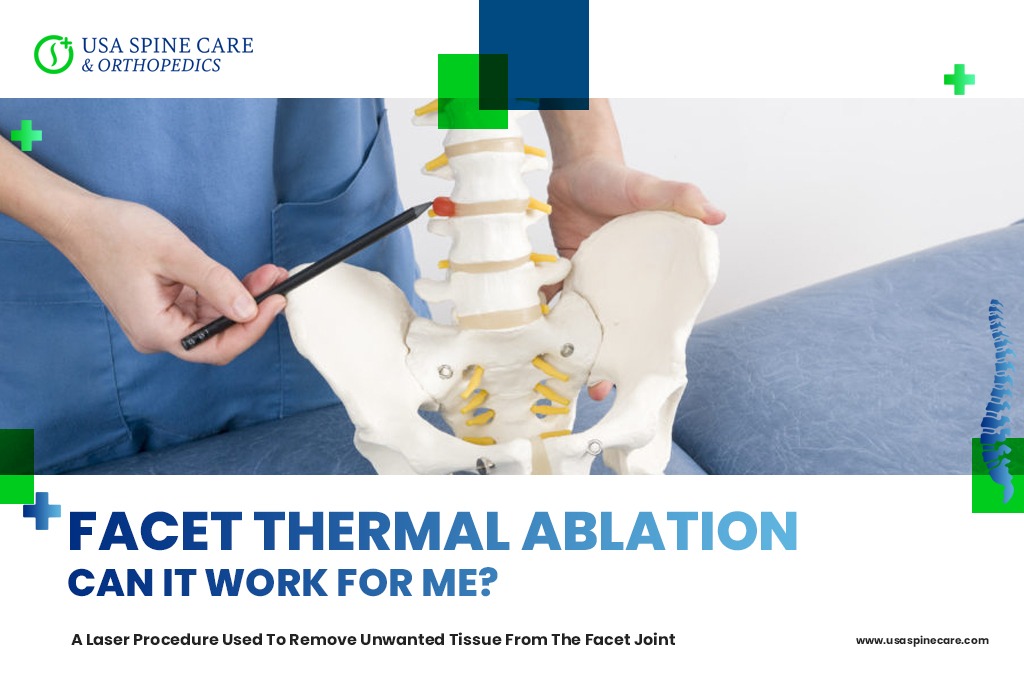- Conditions
- Procedures
- Patient care
- Why choose us
- Our Doctors
- Contact
Can a Facet Thermal Ablation Work for Me?

Chronic pain caused by inflammation of a nerve in the spinal facet joints can affect nearly every aspect of your life. Whether you are retired or still in the workforce, the pain and mobility problems can make once easy tasks difficult to impossible and make it difficult to spend time with loved ones. While many patients are able to find relief from conservative options such as over-the-counter medication or hot and/or cold therapy, others can find symptoms worsening over time.
For patients looking for relief from facet joint pain, a facet thermal ablation can provide relief. This is a minimally invasive, outpatient procedure that uses a laser to heat sensory nerves in the joint. By disrupting the pain signal, patients can find relief on a long-term basis.
If you are researching potential treatment options for neck or back pain, facet thermal ablation may be a procedure that can work for you. The USA Spine Care team is providing the following information to help you learn more about effective therapies and make educated choices about your care. We’re happy to help if you have any questions or would like to learn more.
What does a facet thermal ablation treat?
In the spinal column, the vertebral bone segments are connected by facet joints. Each vertebra has two pairs that join together with the segment above and below, allowing us to bend and flex our neck and back. The most common cause of facet joint pain as we get older is arthritis, which leads to inflammation of the facet joints.
In addition to stiffness and grinding sensations, one of the ways that chronic pain can develop as a result of spinal arthritis is due to irritation of the sensory nerves in the joint. Inflamed joint tissue can rub up against these nerves, causing severe pain and discomfort. While there are other forms of treatment and surgical procedures for facet disease, a facet thermal ablation can be effective because it disrupts the pain signal right at the source.
How do I know if I’m a candidate for facet thermal ablation?
Although it is a minimally invasive procedure, facet thermal ablations are elective and should be seen as a last resort treatment option. People considering spine surgery to relieve facet joint pain typically have chronic pain that is severely affecting their quality of life and interfering with daily activities.
Additionally, doctors will recommend that patients first thoroughly explore nonsurgical treatments before exploring the possibility of surgery. Effective conservative therapies for spinal arthritis and facet joint pain can include:
- Nonsteroidal anti-inflammatory drugs (NSAIDs)
- Periods of rest and activity modification
- Hot and/or cold compression therapy
- Posture improvement
- Lifestyle changes including nutritional counseling, getting regular exercise and quitting smoking, if needed
- Physical therapy
- Facet injections
You and your doctor may begin to consider surgery such as a facet thermal ablation if a full course of conservative treatments have not been effective in relieving pain, or if symptoms suddenly worsen.
When meeting with a surgeon to discuss a spine procedure, you can expect a thorough discussion of your symptoms, a review of diagnostic imagery to identify the source of pain as well as a physical evaluation to ensure there is not a medical condition that would preclude your ability to undergo surgery.
What should I expect from the procedure and the recovery process?
Facet thermal ablation can be performed at an ambulatory surgery center as an outpatient procedure. First, your surgeon makes a very small incision at the location of the inflamed facet joint. He or she will use muscle-sparing techniques and direct visualization to guide surgical equipment to the problematic nerve. Your surgeon will then use a laser to carefully heat the nerve endings that are causing pain. These are sensory nerves only, so only pain signals are disrupted without affecting movement.
You can expect to return home the night of the surgery and you will receive detailed instructions for recovery and a timeline for resuming daily activities.
Facet thermal ablations are often performed in conjunction with other minimally invasive spinal decompression procedures, such as discectomy or foraminotomy.
Learn more about facet thermal ablation from USA Spine Care
USA Spine Care and our team of highly skilled spine and orthopedic surgeons have spent years helping patients find lasting relief from facet disease-related chronic pain. Our state-of-the-art procedures can help people dealing with chronic pain get back to the people and activities they’ve been missing out on. We are leaders in interdisciplinary spine care, which means we can help you on your treatment journey no matter what your individual needs are — from conservative therapy to outpatient surgery. Our compassionate team believes in patient-centered care that is built on trust and education so you can feel involved and empowered in your treatment.
To learn more and find out if facet thermal ablation can help you, reach out to our team today.
